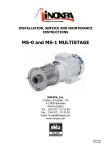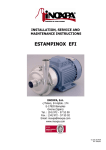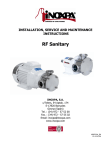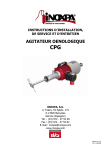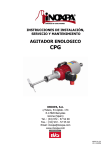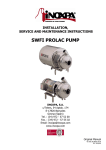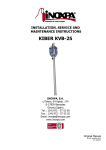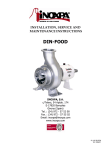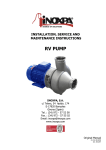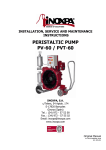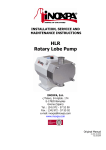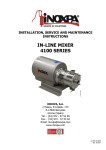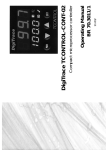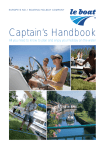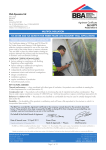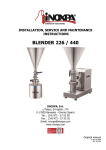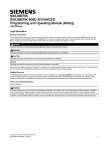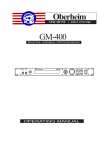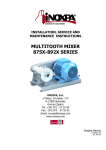Download DIN-FOOD
Transcript
INSTALLATION, SERVICE AND MAINTENANCE INSTRUCTIONS DIN-FOOD INOXPA, S.A. c/Telers, 54 Aptdo. 174 E-17820 Banyoles Girona (Spain) Tel. : (34) 972 - 57 52 00 Fax. : (34) 972 - 57 55 02 Email: [email protected] www.inoxpa.com MIDF-01_EN ED. 18.07/05 MANUFACTURER DECLARATION According the EC directive about machines 98/37/CE, Annex II B The manufacturer: INOXPA, S. A. c/ Telers, 54 17820 Banyoles (Girona) - Spain Hereby declares, that the pumps DIN-FOOD CENTRIFUGAL PUMP Denomination Type 2005 Manufacturing year Comply with the pertinent disposition, in the execution supplied by INOXPA, S.A. for the incorporation in a machine or installation, or for the assembly with other machines as a subunit of other higher order machine. Harmonized norms used, particularly: EN ISO 12100-1/2, EN 809 The machine above must not be put into service until the machinery into which it has been incorporated have been declared in conformity with the EC Machinery Directive. It must meet, particularly, the standards EN 294, EN 563, EN 809 y EN 953 in its respective current editions. Year of CE marking: CE 95 Banyoles, January 1995 EC DECLARATION OF CONFORMITY According the EC directive about machines 98/37/CE, Annex II A The manufacturer: INOXPA, S. A. c/ Telers, 54 17820 Banyoles (Girona) - Spain Hereby declares, that the pump CENTRIFUGAL PUMP Denomination DIN-FOOD Type 2005 Manufacturing year Are in conformity with the essential requirements of the Machinery Directive 98/37/CE (latest modifications included) and according the following Council Direcitves and harmonized norms: - 73/23/CE Directive “low voltage” - Norms EN ISO 12100-1/2, EN 809 Year of CE marking: CE 95 Banyoles, January 1995 1. Safety 1.1. INSTRUCTION MANUAL This instruction manual contains information on the reception, installation, operation, fitting, stripping and maintenance for the DIN-FOOD pump. The information given herein is based on the most up-to-date data available. INOXPA reserves the right to modify this instructions manual without having to give prior notice. 1.2. START-UP INSTRUCTIONS This instruction manual contains vital and useful information for properly operating the pump and for keeping it in good running condition. Not only should the safety instructions set forth in this chapter be carefully read before putting the pump into operation, but those concerned must also familiarise themselves with the operating features of the pump and strictly adhere to the instructions given herein. It is extremely important that these instructions be kept in a set place near the installation. 1.3. SAFETY 1.3.1. Warning signs Danger for people in general. Danger of injury caused by rotating parts of the equipment. Danger! Electricity. Danger! Caustic or corrosive agents. Danger! Suspended loads. Danger to the proper operating of the machine. Obligation to ensure safety at work. Use of safety goggles obligatory. 1.4. GENERAL SAFETY INSTRUCTIONS Please read the instruction manual carefully before installing and commissioning the pump. Should you have any doubts or queries, contact INOXPA. 1.4.1. During the installation You must always bear in mind the Technical Specifications set forth in Chapter 8. Do not put the pump into operation before connecting it to the pipes. Do not put the pump into operation if the cover of the pump has not been fitted and the impeller fixed in the pump. Check that the motor specifications are correct, especially if there is a special risk of explosion due to the work conditions. During the installation procedure, all the electrical work must be carried out by duly authorised personnel. 1.4.2. During operation You must always bear in mind the Technical Specifications set forth in Chapter 8. The limit values that have been set must NEVER be exceeded. NEVER touch the pump or pipes whenever the pump is being used to decant hot liquids or during the cleaning procedure. ED. 18.07/05 1.Safety 3 The pump has moving parts. Do not put your fingers into the pump when it is operating. NEVER work with the suction and the delivery valves shut off. NEVER directly sprinkle the electric motor with water. Standard motor protection is IP-55: dust and water sprinkling protection. 1.4.3. During maintenance You must always bear in mind the Technical Specifications set forth in Chapter 8. NEVER strip the pump down until the pipes have been drained. Remember that there will always be some liquid left in the pump casing (if it has not been fitted with a drain). Always remember that the liquid that has been pumped may be dangerous or subject to high temperatures. For situations of this type, please consult the prevailing regulations in the country in question. Do not leave loose parts on the floor. ALWAYS turn the power supply to the pump off before embarking on maintenance work. Take out the fuses and disconnect the wires from the motor terminals. All electrical work must be carried out by duly authorised personnel. 1.4.4. In accordance with the instructions Any failure to comply with the instructions could lead to a hazard for the operators, the atmospheric conditions of the room, and the machine, and it could lead to a loss to any right to make a claim for damages. Such non-compliance could bring with it the following risks: • Important operating failures of the machine / plant. • Failure to comply with specific maintenance and repair procedures. • Potential electrical, mechanical and chemical hazards. • Atmospheric conditions in the room could be hazardous due to the release of chemical substances. 1.4.5. Warranty We wish to point out that any warranty issued will be null and void and that we are entitled to an indemnity for any civil liability claim for products which might be filed by third parties if: • Operation and maintenance work has not been done following the corresponding instructions; the repairs have not been made by our personnel or have been made without our written authorization; • Modifications are made to our material without prior written authorization; • The parts or lubricants used are not original INOXPA parts/lubricants; • The material has been improperly used due to error or negligence or have not been used according to the indications and the intended purpose. • The parts of the pump have been damaged as a result of having been exposed to strong pressure as there was no safety valve. The General Delivery Terms which you have already received are also applicable. No modification can be made to the machine without the prior consent of the manufacturer. For your safety, use spare parts and original accessories. The use of other parts exempts the manufacturer from any and all responsibility. Any change in operating conditions can only be done with the prior written consent of INOXPA. In the event of doubt or should you require a fuller explanation on particular data (adjustment, assembly, disassembly...), please do not hesitate to contact us 4 1.Safety ED. 18.07/05 2. Index 1. Safety 1.1. INSTRUCTION MANUAL ................................................................................................... 3 1.2. START-UP INSTRUCTIONS............................................................................................... 3 1.3. SAFETY........................................................................................................................... 3 1.4. GENERAL SAFETY INSTRUCTIONS.................................................................................... 3 2. Index 3. General Information 3.1. DESCRIPTION ................................................................................................................. 7 3.2. OPERATING PRINCIPLE ................................................................................................... 7 3.3. APPLICATION.................................................................................................................. 7 4. Installation 4.1. PUMP RECEPTION ........................................................................................................... 9 4.2. TRANSPORT AND STORAGE............................................................................................. 9 4.3. LOCATION .....................................................................................................................10 4.4. COUPLING .....................................................................................................................10 4.5. PIPES ............................................................................................................................11 4.6. PRESSURE TANK ............................................................................................................11 4.7. ELECTRICAL INSTALLATION ...........................................................................................11 5. Start-up 5.1. START-UP ......................................................................................................................13 6. Operating problems 7. Maintenance 7.1. GENERAL MAINTENANCE ................................................................................................15 7.2. DRY THREAD TORQUE ...................................................................................................15 7.3. OILING ..........................................................................................................................15 7.4. STORAGE.......................................................................................................................15 7.5. CLEANING......................................................................................................................16 7.6. PUMP DISASSEMBLY/ASSEMBLY......................................................................................17 8. Technical Specifications 8.1. TECHNICAL SPECIFICATIONS .........................................................................................22 8.2. WEIGHTS.......................................................................................................................22 8.3. DIN-FOOD DIMENSIONS (BARESHAFT) ...........................................................................23 8.4. DIN-FOOD DIMENSIONS (BARESHAFT WITH BASE PLATE)...............................................24 8.5. DIN-FOOD DIMENSIONS (MONOBLOCK)..........................................................................24 8.6. DIN-FOOD DIMENSIONS (MONOBLOCK WITH CAPOT) .....................................................26 8.7. DIN-FOOD PUMP (BARESHAFT).......................................................................................27 ED. 18.07/05 2.Index 5 8.8. DIN-FOOD PUMP (MONOBLOCK) .................................................................................... 28 8.9. DIN-FOOD PUMP SECTION (BARESHAFT) ....................................................................... 29 8.10. PARTS LIST DIN-FOOD PUMP (BARESHAFT) ................................................................. 30 8.11. DIN-FOOD PUMP SECTION (MONOBLOCK).................................................................... 31 8.12. PARTS LIST DIN-FOOD PUMP (MONOBLOCK)................................................................ 32 8.13. DIN-FOOD FLUSHED MECHANICAL SEAL....................................................................... 33 8.14. DIN-FOOD DOUBLE MECHANICAL SEAL ........................................................................ 34 6 2.Index ED. 18.07/05 3. General Information 3.1. DESCRIPTION INOXPA DIN-FOOD series centrifugal pumps with volute that made of a pump housing of thick plate, which has been cold pressed. The parts that come in contact with the product are made of AISI316L stainless steel with a Ra = 0.8µm interior finish. The DIN-FOOD pump is built as monoblock unit with volute motor casing, axial suction and radial impeller, while the connections are DIN-11864-2-B PN-10 flanges. The pump impeller has been designed as a single-bodied, half-open doublecurved part. The mechanical seal is balanced and completely sanitary, the springs are protected in order to prevent their contact with the product. The friction surfaces are made of silicon carbide, graphite and EPDM joints in the standard version. The motor is designed in accordance with IEC Standards, has IP-55 protection and Class F insulation. Three-phase 220-240 / 380-420 or 380-420 / 660 V feed at 50 Hz, in accordance with power supply. Motors adapted to operate under explosive conditions can be supplied upon request. In accordance with the prevailing environmental conditions, the motors can be explosion proof (EExd) or have increased safety features (EExe). The DIN-FOOD series has been especially designed to comply with all the hygienic demands required by the food industry. As far as hygiene, reliability and robustness are concerned, the whole range meets all of the requisites demanded by aforementioned industries. Due to its design qualities, optimum interchangeability is to be had between parts. 3.2. OPERATING PRINCIPLE The pump impeller, housed in the pump housing, turns along with the pump shaft. It is fitted with a certain number of blades in accordance with the model of pump chosen. Given this design, the impeller blades transmit both pressure and kinetic energy to the fluid in question. The pump cannot be reversed by simply changing of the rotation direction. The rotation direction, to be seen from the rear of the motor, should be clockwise. 3.3. APPLICATION In general terms, DIN-FOOD pumps, at least in their standard version, are mainly used in the food industry to decant liquids. Each different type of pump has special hydraulic features in accordance with the pump impeller diameter and various speeds. In the curves reflecting the characteristics, we are also given the required NPSH and the absorbed power. 3.3.1. Field of application ED. 18.07/05 3.General Information 7 Each pump has a limited field of application. The pump in question was selected for certain pumping conditions at the time the order was made. INOXPA is not liable for any damages that might arise if the information furnished by the purchaser is incomplete (nature of the liquid, RPM…). 8 3.General Information ED. 18.07/05 4. Installation 4.1. PUMP RECEPTION INOXPA is not responsible for any deterioration of the material as a result of its transportation or unpacking. Visually check that the packing has not suffered any damage. The pump will be accompanied by the following documentation: • Dispatch notes. • Pump Instruction and Service Manual. • Motor Instruction and Service Manual (*). • (*) If the pump has been supplied with a motor from INOXPA. Unpack the pump and check the following: • The pump suction and delivery connections, removing the remains of any packing material. • Check that the pump and the motor have not suffered any damage. • Should the pump not be in proper condition and/or does not have all the parts, the haulier must draw up a report as soon as possible with regard to the same. 4.1.1. Pump identification and marking Serial number Pump plate 4.2. TRANSPORT AND STORAGE DIN-FOOD pumps are quite often too heavy to be put into their storage space manually. Lift the pump as is shown below: ED. 18.07/05 4.Installation 9 4.3. LOCATION • Position the pump as near as possible to the suction tank, and whenever possible below the level of the liquid. • Place the pump in such a way that there is enough space around it to provide access both to the same and to the motor. (See Chapter 8. Technical Specifications to consult dimensions and weights). • Place the pump on a level and flat surface. • The basement must be rigid, horizontal and against any vibration. Install the pump in such a way that it can be properly ventilated. If the pump is to be installed outside, it must be done so under cover. Its positioning must enable easy access for any inspection and maintenance operations that may need to be carried out. 4.4. COUPLING For the couplings selection and assembly consult to the supplier manual. Sometimes the torque of the positive displacement pumps can be high enough. Therefore, a coupling have been chosen 1.5 to 2 the adequate torque. Alignment. The pump and motor shaft of complete units have been accurately pre-aligned in our factory. After installations of the pump unit, the pump and motor shaft should be re-aligned. Place a straight-edge (A) on top of the coupling: the straight should make contact with both halves of the coupling over their entire length. See figure. Repeat the check, but this time on both sides of the coupling near the shaft. For the sake of accuracy, this chech should also be done using an outside caliper (B) at two diametrically opposite points on the outside surfaces of the two halves of the coupling. Maximum alignment deviations: Outside diameter of the coupling [mm.] 70 - 80 81 - 95 96 - 110 111 - 130 131 - 140 141 - 160 161 - 180 181 - 200 201 - 225 10 Va min. [mm.] 2 2 2 2 2 2 2 2 2 Va max. [mm.] 4 4 4 4 4 6 6 6 6 4.Installation Va max. - Va min. [mm.] 0,13 0,15 0,18 0,21 0,24 0,27 0,3 0,34 0,38 Vr. [mm.] 0,13 0,15 0,18 0,21 0,24 0,27 0,3 0,34 0,38 ED. 18.07/05 4.5. PIPES • In general, suction and delivery pipes should be fitted in straight stretches, with the minimum amount of elbows and accessories, in order reduce, as far as possible, any load loss that might be produced by friction. • Make sure that the pump mouths are well aligned with respect to the piping, and that they are similar in diameter to that of the pipe connections. • Position the pump are near as possible to the suction tank, and whenever possible below the level of the liquid, or even lower with respect to the tank in order for the static suction head be at its maximum. • Place brackets for the piping as near as possible to the suction and delivery mouths of the pump. 4.5.1. Shut-off valves The pump can be isolated for the purpose of carrying out maintenance work. To this end, shut-off valves should be fitted at the pump’s suction and delivery connections. These valves must ALWAYS be open whenever the pump is operating. 4.6. PRESSURE TANK For models with double mechanical seal will be necessary the installation of a pressure tank. Install ALWAYS the pressure tank between 1 and 2 meters above the mechanical seals. See the figure 4.6.1. 1...2m Connect ALWAYS the refrigeration liquid input connection with the bottom chamber seal connection. So, the refrigeration liquid outlet will be carried out by the top chamber connection. See the figure 4.6.1. Mechanical seal Figure 4.6.1: Pressure tank connection lay out To obtain further information about the pressure tank (installation, operation, maintenance, … ), consult the instruction manual supplied by the manufacturer. 4.7. ELECTRICAL INSTALLATION Leave the connecting of the electrical motors to qualified personnel. Take the necessary measures to prevent any breakdowns in the connections and wires. The electrical equipment, the terminals and the components of the control systems may still carry an electric charge even when disconnected. Contact with them may put the safety of operators at risk, or cause irreparable damage to the material. Before manoeuvring the pump, make sure that the electric box is switched off. ED. 18.07/05 4.Installation 11 • • Connect the motor in accordance with the instructions supplied by the manufacturer of the same. Check the direction of the rotation (see the signaling label on the pump). Put the pump motor into operation momentarily. Make sure, by looking at the pump from the rear, that the motor’s ventilator is rotating in a clockwise direction. Check ALWAYS the direction of the motor’s rotation with liquid inside the pump. For the models with sealing chamber, make sure always that it is filed of liquid before checking the rotating direction. 12 4.Installation ED. 18.07/05 5. Start-up Before putting the pump into operation read carefully the instructions on installation given in Chapter 4. Installation. 5.1. START-UP Read Chapter 8. Technical Specifications carefully. INOXPA will not assume responsibility for any improper or incorrect use of the equipment. Do not touch the pump or the piping while it is pumping products at a high temperature. 5.1.1. Checks to be carried out before putting the pump into operation • Completely open the pipes’ suction and delivery shut-off valves. • Check oil level of the pump. Add correct grade of oil as necessary to maintain level in center of oil sight glass (In the case of first start-up: pumps are shipped with oil in the gearbox, nevertheless this check may be skipped). • If the liquid fails to flow toward the pump, fill it with the liquid to be pumped. The pump must NEVER rotate without liquid. • Check that the rotation direction of the motor is correct. 5.1.2. Checks to be carried out on putting the pump into operation • Check to make sure that the pump is not making any strange noises. • Check to see if the absolute inlet pressure is sufficient, in order to avoid cavitations in the pump. Consult the curve for the minimum required pressure above the steam pressure (NPSHr). • Monitor the delivery pressure. • Check that there are no leaks in the sealed areas. A shut-off valve should not be used in the suction pipe to regulate the flow rate. It must be completely open during operation. Monitor motor consumption in order to avoid a circuit overload. Reduce the flow and the power consumed by the motor: • Regulating the flow to the pump delivery. • Decreasing motor speed. ED. 18.07/05 5.Start-up 13 6. Operating problems The table given below provides solutions to problems that might arise during pump operation. With respect to the same, it is assumed that the pump has been properly installed and has been correctly selected for the application in question. Should there be a need for technical service please contact INOXPA. Operating problems Probable causes Overloading of motor. Insufficient flow rate or pressure in pump. No pressure on the discharge side. Irregular discharge flow rate / pressure. Noise and vibrations. The pump gets clogged. Overheating of the pump. Abnormal wear. Leak in mechanical seal. 8, 9, 13, 20, 21, 22, 23, 24. 1, 2, 4, 5, 7, 9, 10, 17, 19. 2, 3, 6, 18. 1, 2, 4, 5, 6, 9. 2, 4, 5, 6, 7, 8, 9, 10, 13, 14,15, 20, 21, 22, 23, 24. 9, 10, 13, 15, 20, 21, 22, 24. 8, 9, 10, 13, 15, 20, 21, 22, 23, 24. 4, 5, 10, 15, 20, 24. 11, 12, 16. Probable causes Solutions 1 2 Wrong rotation direction. Insufficient NPSH. 3 4 5 6 7 Non-purged pump. Cavitation. The pump is sucking air. Obstructed suction piping. Delivery pressure is too high. 8 Flow is too high. 9 10 11 12 The viscosity of the liquid is too high. The temperature of the liquid is too high. Mechanical seal either damaged or worn. Unsuitable O-ring for the liquid in question. 13 The impeller is rubbing. 14 15 16 17 18 19 Pressure in the pipes. There are foreign bodies in the liquid. The tension of the mechanical seal spring is too low. The pump speed is too low. The suction shutoff valve is closed. Delivery pressure is too low. 20 21 22 23 24 Worn bearing. Not enough lubricating oil. Unsuitable lubricating oil. Non aligned coupling. Pump and/or motor not fixed to the base-plate. Change the direction of the rotation. Increase the NPSH available: - Raise the suction tank. - Lower the pump. - Decrease the steam tension. - Increase the diameter of the suction piping. - Shorten and simplify the suction piping. Purge or fill. Increase the suction pressure.( See Number 2 also) Check the suction piping and all of its connections. Check the suction piping and the filters, if there are any. If necessary, decrease the load losses by increasing the diameter of the piping, for example. Decrease the flow: - Reduce the flow by means of a diaphragm. - Partially close off the delivery valve. - Trim the impeller. - Decrease the speed. Decrease the viscosity by heating the liquid, for example. Decrease the temperature of the liquid by cooling it. Replace the seal. Fit more suitable O-ring by consulting the supplier with respect to the same. - Lower the temperature. - Lower suction pressure. - Adjust impeller / cover set. Connect the pipes to the pump without pressure. Place a filter at the suction piping. Adjust in accordance with the instructions given herein. Increase the speed. Check and open. Increase the pressure: - Increase the diameter of the impeller. - Increase pump speed. Replace the bearings; check the pump. Fill with oil. Use adequate oil. Align coupling. Affix the pump and/or the motor to the base-plate, check to see if the pipes are connected without pressure and align the coupling. If the problems persist stop using the pump immediately. Contact the pump manufacturer or his representative. 14 6.Operating problems ED. 18.07/05 7. Maintenance 7.1. GENERAL MAINTENANCE This pump, as with any other machine, needs to be maintained. The instructions contained in this manual deal with the identification and replacement of the spare parts. These instructions have been drawn up by maintenance staff and are destined for those people who are responsible for supplying spare parts. Read carefully Chapter 8. Technical specifications. All the parts or materials that are changed must be duly eliminated/recycled in accordance with the prevailing directives in each area. ALWAYS disconnect the pump before starting out on any maintenance work. 7.1.1. Check the mechanical seal Periodically check that there are no leaks in the shaft area. Should there be any leaks in the mechanical seal area, replace the same pursuant to the instructions given in the section entitled Stripping and Assembly of the pump. 7.2. DRY THREAD TORQUE Material Dry thread torque [N.m.] M5 M6 M8 M10 M12 M14 M16 M18 M20 8.8 6 10 25 49 86 135 210 290 410 A2 5 9 21 42 74 112 160 210 300 7.3. OILING The bearings are oiled by immersion in an oil bath. The pumps are supplied with oil. • Regularly check the oil level, for example, weekly or eery 150 operating hours. • The first oil change must be carried out after 150 hours of operation. • Afterwards, it can be changed every 2500 operating hours or at least once a year when operating under normal conditions. When change the oil: the oil sump must be filled up to the level in the middle of the peephole. Do not pour too much oil into the sump. Leave the pump switched off for a while and then re-check the oil level; if necessary, add a little oil. Oils for environment temperatures of 5 to 50ºC: ISO VG 68 PUMP TYPE Quantity of oil in the support (l.) 125-100-250 125-100-315 125-100-400 150-125-250 150-125-315 150-125-400 200-150-250 1,75 200-150-315 200-150-400 2 7.4. STORAGE Before being stored the pump must be completely emptied of liquids. Avoid, as far as possible, the exposure of the parts to excessively damp atmospheres. ED. 18.07/05 7.Maintenance 15 7.5. CLEANING The use of aggressive cleaning products such as caustic soda and nitric acid may give rise to skin burns. Use rubber gloves during the cleaning process. Always use protective goggles. If the pump is installed in a system fitted with a CIP process, there will be no need for stripping. If it is not fitted with an automatic cleaning process, strip the pump pursuant to the instructions given in the section entitled Stripping and Assembly of the pump. Cleaning solutions for CIP processes. Only use clear water (chloride free) to mix with the cleaning agents: a) Alkaline solution: 1% in weight of caustic soda (NaOH) to 70ºC (150ºF) 1 Kg NaOH + 100 l. water = cleaning solution or 2.2 l. NaOH al 33% + 100 l. of water = cleaning solution b) Acid solution: 0.5% in weight of nitric acid (HNO3) to 70ºC (150ºF) 0.7 liters HNO3 to 53% + 100 l. water = cleaning solution Monitor the concentration of cleaning solutions, it could give rise to the deterioration of the pump sealing gaskets. In order to remove any remains of cleaning products, ALWAYS rinse the element in question with clean water after completing the cleaning process. 16 7.Maintenance ED. 18.07/05 7.6. PUMP DISASSEMBLY/ASSEMBLY 7.6.1. Pump casing and impeller Disassembly Remove the hexagonal screws (52) and washers (53) that fix the pump housing (01) to the lantern (04). Remove the impeller blind nut (45) and the O-ring (80D), then take the impeller out (02). Assembly Slip the impeller (02) onto the shaft (05) until it reaches the rotational part of the mechanical seal (08), fit the O-ring (80D) into the blind nut slot (45) and tighten the nut (45). Fit the pump housing (01) and fix it to the lantern (04) with the hexagonal screws (52) and the washers (53). ¡IMPORTANT! When assembling the new seal, be careful and mount the parts and the O-rings with soapy water in order to allow an easy glide of the parts, either the stationary part and the rotary part on the shaft. ED. 18.07/05 7.Maintenance 17 7.6.2. Simple mechanical seal Disassembly Remove the rotational part from the mechanical seal (08). Take off the pump cover (03), the fixed part of the mechanical seal (08) will remain housed in the cover. Remove the fixed part of the mechanical seal (08). Assembly Check the situation of the shaft (05) in relation to the pump cover (03). See the chapter 7.6.5. Shaft pump fitting. Fit the pump cover (03) to the lantern (04). Place the fixed part of the mechanical seal in the cover housing (03) taking the stud into account. Check to make sure that the assembly measurement is that which is given below: Slide the rotating part of the mechanical seal (08) over the shaft (05) until it can go no further. 18 Seal diameter 53 34,5 60 37,5 A 7.Maintenance ED. 18.07/05 7.6.3. Flushed mechanical seal Disassembly Remove the rotating part of the mechanical seal (08). Take off the pump cover (03) leaving the ring (30) and the lid (10) as they are. The fixed parts of the mechanical seal (08, 08B) will remain housed in the group. Remove the fixed part from the inner seal (08) taking the stud into account. Remove the screws (52C), the fixed part of the outer seal will come out (08B). Loosen the studs (55A) in order to remove the rotating part from the outer seal (08A) with the sleeve (13). Assembly Check the situation of the shaft (05) in relation to the pump cover (03). See the chapter 7.6.5. Shaft pump fitting. Fit the sleeve (13) until it can go no further on the shaft (05). Fit the rotating part of the outer mechanical seal (08A) with the gasket and spring on the sleeve (13) and fix the shaft (05) by means of the studs (55A). Position the O-ring (80B) on the pump cover centering (03). Fit the lid (10) in this centering, the fixed part of the outer seal (08B), the cool seal ring (30) and fix the whole to the pump cover (03) by means of the hexagonal screws (52C). Carefully fit this whole group to the lantern center (04). At the same time, the two rub faces of the outer seal will touch (08A, 08B). See the section on the assembly of the simple mechanical seal in order to fit the inner mechanical seal. ED. 18.07/05 Seal diameter 53 34,5 60 37,5 A 7.Maintenance 19 7.6.4. Double mechanical seal Disassembly Remove the shaft separator (17). Remove the screws (52C), thus freeing the external cover (10B). Remove the group of the three fitted covers (03A, 10A and 10C), the fixed part of the inner mechanical seal (08) will remain housed in the internal cover (10C). Loosen the screws (52D) to strip the internal cover (10C) and the double seal lid (10A) from the pump cover (03A). Loosen the studs from the rotating parts of the seals. Then, remove these rotating parts from the mechanical seals (08, 08A) of the shaft (05A). Remove the external cover (10B), the fixed part of the exterior mechanical seal (08A) will remain housed in the cover. Assembly Check the situation of the shaft (05) in relation to the pump cover (03). See the chapter 7.6.5. Shaft pump fitting. Position the fixed part of the mechanical seal (08A) in the cover housing (10B), taking the stud into account. Fit into the external cover (10B), leaving it loose at the end of the shaft (05A). Slip on the rotating part of the outer mechanical seal (08A). Fix in accordance with the assembly dimensions indicated. Fit the rotating part of the internal mechanical seal (08) up to the outer seal (08A), and then fix it. Place the fixed part of the internal seal (08) into the cover housing (10C), taking the stud into account. Fit the covers (03A, 10A and 10C) by means of the screws (52D). Position the aforementioned covers in the lantern (04) and fix the external cover (10B) with the screws (52C). Fit the separator (17) up to the back of the shaft (05A). 20 Seal diameter 53 A 62,5 60 68 7.Maintenance ED. 18.07/05 7.6.5. Shaft pump fitting Check that the shaft (05) assembly dimension in relation to the pump cover (03) is in accordance with the indicated below: Tipo bomba 250 Diámetro cierre 53 16 300 53 8 400 60 20 A Otherwise adjust the assembly dimension in accordance with the indicated below. • For monoblock models; loosen the studs (55) and slide the shaft (05) until it can go no further. Finally, fix the studs. • For bareshaft models; loosen the hexagonal screws (52A) and the nuts (54), adjust the assembly dimension by means of the studs (55). Once time it has been adjusted, fix the studs (54) and the screws (52A). 7.6.6. Lantern and motor (MONOBLOCK) Disassembly Remove the hexagonal screws (52A), the nuts (54) and the washers (53, 53A). Then, the lantern (04) could be removed. Loosen the studs (55) and remove the shaft (05). Remove the screws (52B), the nuts (54A) and the washers (53B). Then, the motor (93) could be removed from the base plate. Assembly Place the motor (93) on the base plate (38) and fix them by means of the screws (52B), the nuts (54) and the washers (53B). Slide the shaft (05) over the motor shaft (93) until it can go no further. Fix the studs (55). Place the lantern (04) on the motor (93) and fix them by means of hexagonal screws (52A), the nuts (54) and the washers (53) and (53A). ED. 18.07/05 7.Maintenance 21 8. Technical Specifications 8.1. TECHNICAL SPECIFICATIONS 50Hz -1 Maximum flow rate (1450 min ) .............................................. Maximum differential pressure ................................................ Maximum suction pressure ...................................................... Maximum operating pressure .................................................. Operating temperature ........................................................... Maximum speed ..................................................................... Suction / delivery connections ................................................. 60Hz 3 1000 m /h 6 bar (87 PSI) 14 bar (203 PSI) 20 bar (290 PSI) -10 ºC a +140ºC (EPDM) 14 ºF a 284 ºF (EPDM) 1450 min-1 DIN 11864-2 (estándar) 1000 m3/h 9 bar (131 PSI) 11 bar (160 PSI) 20 bar (290 PSI) -10 ºC a +140ºC (EPDM) 14 ºF a 284 ºF (EPDM) 1750 min-1 DIN 11864-2 (estándar) Whenever the noise level in the area of operation exceeds 85 dB(A) use special protection. Materials Parts in contact with the product ............................................... Other parts in stainless steel ..................................................... Gaskets and joints in contact with the product ........................... Other optional joints materials .................................................. Surface finish .......................................................................... Mechanical seal Seal type ................................................................................ Flushed mechanical seal Maximum pressure .................................................................. Flow ....................................................................................... Double mechanical seal Operating pressure.................................................................. Mechanical seal materials AISI 316L AISI 304 EPDM (standard) Consult your supplier Standard finish Single internal mechanical seal 1 bar (14,5 PSI) 6-10 l/min 1,5~2 bar (22~29 PSI) over the pump operating pressure Type of mechanical seal Flushed Double [ atmospheric side ] Graphite Silicon carbide Single internal Stationary part Rotary part Double [ product side ] Silicon carbide 8.2. WEIGHTS Pump Type - bareshaft - 22 125-100-250 Weight [Kg] 113 Weight [lbs] 249 125-100-315 127 280 125-100-400 135 298 150-125-250 118 260 150-125-315 133 293 150-125-400 149 329 200-150-250 124 273 200-150-315 194 428 200-150-400 210 463 Pump Type - monoblock 125-100-250 150-125-250 200-150-250 8.Technical Specifications MOTOR Weight [Kg] Weight [lbs] 160 204 449 180 239 526 160 210 462 180 256 563 180 263 579 200 360 792 ED. 18.07/05 8.3. DIN-FOOD DIMENSIONS (BARESHAFT) DIN 11864-2-A flange dimensions PUMP TYPE DN D k d4 100 159 137 117 125 183 161 142 150 213 188 168 200 263 238 218 DNa DNi d l 125-100-250 125-100-315 125 100 42 110 a 121 125-100-400 130 150-125-250 128 150-125-315 150 125 42 110 150-125-400 140 200-150-250 200-150-315 200-150-400 ED. 18.07/05 137 42 200 150 48 142 110 153 d2 8 x ∅11 8 x ∅14 f h1 h2 522 250 316 280 352 330 402 250 355 280 372 330 422 537 250 375 670 280 402 667 330 452 510 530 518 b m1 m2 90 160 120 100 200 90 100 90 100 8.Technical Specifications n1 n2 440 350 490 400 150 550 450 23 160 120 440 350 18 200 150 490 400 550 450 440 350 490 400 550 450 200 150 n3 110 110 s1 18 23 110 140 s2 363 14 350 370 14 14 23 w 18 358 378 500 498 23 8.4. DIN-FOOD DIMENSIONS (BARESHAFT WITH BASE PLATE) PUMP TYPE MOTOR DNa 125-100-250 150-125-250 200-150-250 125-100-315 150-125-315 200-150-315 125-100-400 150-125-400 200-150-400 24 160 160 180 160 160 180 180 160 180 180 200 160 160 180 180 200 160 180 180 200 225 160 180 200 225 250 280 200 225 250 280 225 250 280 280 315 225 250 280 280 315 315 315 M L M M L M L L M L L M L M L L L M L L L M L 125 150 200 125 150 200 DNi 100 125 150 100 125 150 a 121 128 142 121 137 153 M S L M S M S M S M S M S M L 125 150 200 100 125 150 130 140 153 f 1250 1290 1330 1265 1305 1345 1365 1330 1365 1385 1405 1240 1280 1315 1335 1355 1305 1340 1360 1380 1490 1470 1510 1550 1660 1725 1820 1365 1475 1540 1705 1495 1560 1725 1785 1790 1655 1720 1885 1945 1950 2090 2120 h1 h2 b 316 35 l 550 m1 m2 m3 n1 n2 1300 1020 620 565 1350 990 s w 1335 565 550 355 40 1340 565 340 140 550 375 35 565 620 1335 580 352 35 595 1385 650 580 372 30 370 45 595 650 670 580 595 650 180 1380 23 1395 720 1545 1500 1140 1735 1700 1300 1370 1350 990 1520 1710 1380 1530 1500 1700 1350 1500 1140 1300 990 1140 870 1720 1700 1300 935 1820 1800 1400 720 1545 1500 1140 665 670 402 35 20 420 820 700 720 10 870 30 720 422 20 430 45 420 452 870 1735 1700 1300 935 1835 1800 1400 200 180 200 180 200 820 765 720 665 820 765 180 35 430 200 8.Technical Specifications ED. 18.07/05 8.5. DIN-FOOD DIMENSIONS (MONOBLOCK) DIN 11864-2-A flange dimensions DN D k d4 100 159 137 117 125 183 161 142 150 213 188 168 200 263 238 218 PUMP TYPE 125-100-250 MOTOR DNa DNi 160 a 125 100 121 180 150-125-250 160 180 200 ED. 18.07/05 8 x ∅11 8 x ∅14 f h1 850 h2 b c c1 150 125 128 865 l 475 250 90 68 355 965 1005 340 m1 m2 n1 n2 n3 n4 s1 s2 160 120 367 18 440 350 415 470 18 200 68 88 400 305 585 210 8.Technical Specifications 349 374 475 375 w 342 360 260 460 945 200 150 142 c2 460 316 930 180 200-150-250 d2 150 381 23 600 545 545 600 23 384 25 8.6. DIN-FOOD DIMENSIONS (MONOBLOCK WITH CAPOT) DIN 11864-2-A flange dimensions DN D k d4 100 159 137 117 125 183 161 142 150 213 188 168 200 263 238 218 PUMP TYPE 125-100-250 MOTOR DNa DNi 160 a 125 100 121 d2 8 x ∅11 8 x ∅14 f h1 960 h2 b c c1 c2 l 160 m2 n1 n2 n3 n4 s2 250 975 90 68 360 260 525 369 18 440 350 415 470 18 355 180 200-150-250 180 200 26 w 344 160 120 150 125 128 s1 316 180 150-125-250 m1 351 376 200 150 142 995 1105 340 200 375 68 88 400 305 690 210 8.Technical Specifications 150 383 23 600 545 545 600 23 386 ED. 18.07/05 8.7. DIN-FOOD PUMP (BARESHAFT) ED. 18.07/05 8.Technical Specifications 27 8.8. DIN-FOOD PUMP (MONOBLOCK) 28 8.Technical Specifications ED. 18.07/05 8.9. DIN-FOOD PUMP SECTION (BARESHAFT) ED. 18.07/05 8.Technical Specifications 29 8.10. PARTS LIST DIN-FOOD PUMP (BARESHAFT) Position Description Quantity Material 01 Pump housing 1 AISI 316L 02 Impeller 1 AISI 316L 03 Pump cover 1 AISI 316L 04 Lantern 1 GG-15 05 Shaft 1 AISI 316L 06 Bearing support 1 GG-15 07 Leg 1 GG-15 08 Mechanical seal 1 - 12 Bearing house 1 F-114 12A Bearing cover 1 F-114 18 Front cover gasket 1 Paper gasket 45 Blind nut 1 AISI 316L 47A Protection 2 AISI 304 50A Screw 4 A2 51 Allen screw 6 8.8 51A Allen screw 4 8.8 52 Hexagonal screw 12 A2 52A Hexagonal screw 6 8.8 52B Hexagonal screw 2 A2 53 Grower washer 12 A2 53A Grower washer 2 A2 54 Hexagonal nut 3 8.8 55 Stud 3 8.8 61 Key 1 A2 61A Key 1 F-114 62 Safety nut 1 Steel 63 Safety washer 1 Steel 66 Elastic ring 1 Steel 70 Double angular contact bearing 1 Steel Cylindrical roller bearing 1 Steel O-ring 1 EPDM 70A 80 30 80A O-ring 1 EPDM 80B O-ring 1 NBR 80D O-ring 1 EPDM 85 Oil plug 1 AISI 303 86 Peephole 1 Plastic 87 Bleeder 1 Plastic 88 Lip seal 1 NBR 88A Lip seal 1 NBR 8.Technical Specifications ED. 18.07/05 8.11. DIN-FOOD PUMP SECTION (MONOBLOCK) ED. 18.07/05 8.Technical Specifications 31 8.12. PARTS LIST DIN-FOOD PUMP (MONOBLOCK) 32 Position Description Quantity Material 01 Pump housing 1 AISI 316L 02 Impeller 1 AISI 316L 03 Pump cover 1 AISI 316L 04 Lantern 1 GG-15 05 Shaft 1 AISI 316L 08 Mechanical seal 1 - 38 Base plate 1 AISI 304 45 Blind nut 1 AISI 316L 47A Protection 2 AISI 304 50A Screw 8 A2 52 Hexagonal screw 8 A2 52A Hexagonal screw 4 A2 52B Hexagonal screw 4 A2 53 Grower washer 12 A2 53A Flat washer 4 A2 53B Flat washer 4 A2 54 Hexagonal nut 4 A2 54A Hexagonal nut 4 A2 55 Stud 2 A2 61 Key 1 A2 80A O-ring 1 EPDM 80D O-ring 1 EPDM 93 Motor 1 - 8.Technical Specifications ED. 18.07/05 8.13. DIN-FOOD FLUSHED MECHANICAL SEAL ED. 18.07/05 Position Quantity Description 08A 1 Mechanical seal - rotary part - - 08B 1 Mechanical seal - stationary part - - 10 1 Lid AISI 316L 13 1 Flushed mechanical seal sleeve AISI 316L 30 1 Flushed mechanical seal ring AISI 316L 52C 4 Hexagonal screw A2 55A 3 Stud A2 80B 1 O-ring 92 2 Elbow connection 8.Technical Specifications Material EPDM AISI 316 33 8.14. DIN-FOOD DOUBLE MECHANICAL SEAL 34 Position Quantity Description Material 03A 1 Pump cover AISI 316L 05A 1 Shaft AISI 316L 08 1 Internal mechanical seal - 08A 1 External mechanical seal - 10A 1 Double mechanical seal lid AISI 316L 10B 1 External cover AISI 316L 10C 1 Internal cover AISI 316L AISI 316L 17 1 Separator 52C 4 Hexagonal screw A2 52D 4 Hexagonal screw A2 80B 2 O-ring EPDM 80C 1 O-ring EPDM 80D 2 O-ring EPDM 92 2 Elbow connection 8.Technical Specifications AISI 316 ED. 18.07/05 NOTES INOXPA, S.A. C/ Telers, 54 - PO Box: 174 Tel: (+34) 972 575 200 Email: [email protected] 17820 BANYOLES (Girona - Spain) Fax: (+34) 972 575 502 Web: www.inoxpa.com Gsm: (+34) 629 807 300 BARCELONA – FLUAL, S.L. Tel: 937 297 280 Email: [email protected] MADRID – INOXFLUID, S.L Tel: 918 716 084 Email: [email protected] BILBAO – STA, S.L. Tel: 944 572 058 Email: [email protected] VALENCIA – INOXDIN, S.L. Tel: 963 170 101 Email: [email protected] VALLADOLID – ALTAFLUID, S.L. Tel: 983 403 197 Email: [email protected] JEREZ – CORFLUID, S.L. Tel: 956 140 193 Email: [email protected] ZARAGOZA – FLUAL, S.L. Tel: 976 591 942 Email: [email protected] LA RIOJA – STA, S.L. Tel: 941 228 622 Email: [email protected] SEVILLA – CORFLUID, S.L. Tel: 954 296 852 Email: [email protected] CÓRDOBA – CORFLUID, S.L. Tel: 957 326 542 Email: [email protected] LA MANCHA – INOXFLUID, S.L. Tel: 926 514 190 Email: [email protected] ASTURIAS – STA, S.L. Tel: 985 267 553 Email: [email protected] INOXPA FRANCE, S.A. - AGENCE NORD AGENCE RHÔNE-ALPES 2, Avenue Saint Pierre 59118 WAMBRECHIES (France) Tel: 33(0)320 631000 Fax: 33(0)320 631001 Email: [email protected] Z.l. Chapotin Nord CHAPONNAY 69970 (France) Tel: 33(0)472 709090 Fax: 33(0)472 709091 Email: [email protected] AGENCE SUD EST Route d’Olonzac 11200 HOMPS (France) Tel: 33(0)468 278680 Fax: 33(0)468 278681 Email: [email protected] AGENCE OUEST ZA des Roitelières 44330 LE PALLET (France) Tel: 33(0)228 010172 Fax: 33(0)228 010173 Email: [email protected] INOXPA SKANDINAVIEN A/S H∅egh Guldbergsgade 27 HORSENS DK-8700 (Denmark) Tel: (45) 76 28 69 00 Fax: (45) 76 28 69 09 Email: [email protected] INOXPA ITALIA S.R.L. Via Kennedy, 13 RODANO (MILAN) 20090 (Italia) Tel: 39(0)02 95327292 Fax: 39(0)02 95327168 Email: [email protected] INOXPA SWEDEN Stationsvägen 2 430 63 HINDÅS Tel. +46 (0) 301 21122 Fax +46 (0) 301 21125 Email: [email protected] INOXPA (UK) LTD Unit 2, Ashfield Close, Whitehall Industrial Estate LEEDS WEST YORKSHIRE, LS12 5JB (United Kingdom) Tel: 44(0) 1132 636367 Fax: 44(0) 1132 636384 Email: [email protected] INOXPA SOUTH AFRICA (PTY) LTD 48 Marconi Road Montague Gardens CAPE TOWN 7441 (Republic of South Africa) Tel: 27(0)21 5514533 / 1571 Fax: 27(0)21 5514534 Email: [email protected] S.T.A. PORTUGUESA LDA. Zona Industrial - Lugar do Guardal ALGERIZ. 3730-266 VALE DE CAMBRA (Portugal) Tel: 351 256 472722 Fax: 351 256 425697 Email: [email protected] INOXPA POLAND sp z o.o. Ul. Arkonska, 54 80-392 Gdansk (Poland) Tel. +48 58 511 00 05 Fax +48 58 556 72 51 Email: [email protected] INOXPA USA, Inc 3715 Santa Rosa Avenue Suite A4 Santa Rosa, CA95407 (California) Tel. 1.707.585.3900 Fax 1.707.585.3908 Email: [email protected] INOXPA DEUTSCHLAND Email: [email protected] Además de nuestras delegaciones, INOXPA opera con una red de distribuidores independientes que comprende un total de más de 50 países en todo el Mundo. Para más información consulte nuestra página web. www.inoxpa.com




































